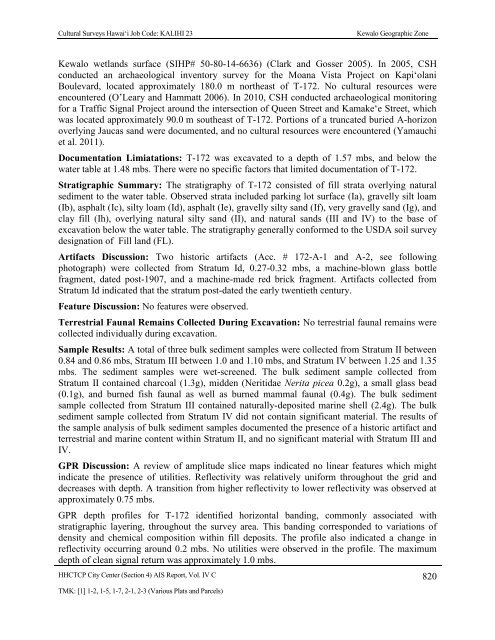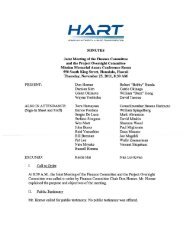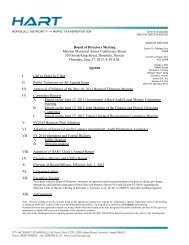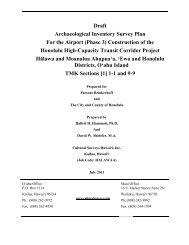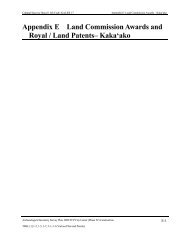4.12 Test Excavation 167 (T-167) - Honolulu Rail Transit Project
4.12 Test Excavation 167 (T-167) - Honolulu Rail Transit Project
4.12 Test Excavation 167 (T-167) - Honolulu Rail Transit Project
Create successful ePaper yourself
Turn your PDF publications into a flip-book with our unique Google optimized e-Paper software.
Cultural Surveys Hawai‘i Job Code: KALIHI 23Kewalo Geographic ZoneKewalo wetlands surface (SIHP# 50-80-14-6636) (Clark and Gosser 2005). In 2005, CSHconducted an archaeological inventory survey for the Moana Vista <strong>Project</strong> on Kapi‘olaniBoulevard, located approximately 180.0 m northeast of T-172. No cultural resources wereencountered (O’Leary and Hammatt 2006). In 2010, CSH conducted archaeological monitoringfor a Traffic Signal <strong>Project</strong> around the intersection of Queen Street and Kamake‘e Street, whichwas located approximately 90.0 m southeast of T-172. Portions of a truncated buried A-horizonoverlying Jaucas sand were documented, and no cultural resources were encountered (Yamauchiet al. 2011).Documentation Limiatations: T-172 was excavated to a depth of 1.57 mbs, and below thewater table at 1.48 mbs. There were no specific factors that limited documentation of T-172.Stratigraphic Summary: The stratigraphy of T-172 consisted of fill strata overlying naturalsediment to the water table. Observed strata included parking lot surface (Ia), gravelly silt loam(Ib), asphalt (Ic), silty loam (Id), asphalt (Ie), gravelly silty sand (If), very gravelly sand (Ig), andclay fill (Ih), overlying natural silty sand (II), and natural sands (III and IV) to the base ofexcavation below the water table. The stratigraphy generally conformed to the USDA soil surveydesignation of Fill land (FL).Artifacts Discussion: Two historic artifacts (Acc. # 172-A-1 and A-2, see followingphotograph) were collected from Stratum Id, 0.27-0.32 mbs, a machine-blown glass bottlefragment, dated post-1907, and a machine-made red brick fragment. Artifacts collected fromStratum Id indicated that the stratum post-dated the early twentieth century.Feature Discussion: No features were observed.Terrestrial Faunal Remains Collected During <strong>Excavation</strong>: No terrestrial faunal remains werecollected individually during excavation.Sample Results: A total of three bulk sediment samples were collected from Stratum II between0.84 and 0.86 mbs, Stratum III between 1.0 and 1.10 mbs, and Stratum IV between 1.25 and 1.35mbs. The sediment samples were wet-screened. The bulk sediment sample collected fromStratum II contained charcoal (1.3g), midden (Neritidae Nerita picea 0.2g), a small glass bead(0.1g), and burned fish faunal as well as burned mammal faunal (0.4g). The bulk sedimentsample collected from Stratum III contained naturally-deposited marine shell (2.4g). The bulksediment sample collected from Stratum IV did not contain significant material. The results ofthe sample analysis of bulk sediment samples documented the presence of a historic artifact andterrestrial and marine content within Stratum II, and no significant material with Stratum III andIV.GPR Discussion: A review of amplitude slice maps indicated no linear features which mightindicate the presence of utilities. Reflectivity was relatively uniform throughout the grid anddecreases with depth. A transition from higher reflectivity to lower reflectivity was observed atapproximately 0.75 mbs.GPR depth profiles for T-172 identified horizontal banding, commonly associated withstratigraphic layering, throughout the survey area. This banding corresponded to variations ofdensity and chemical composition within fill deposits. The profile also indicated a change inreflectivity occurring around 0.2 mbs. No utilities were observed in the profile. The maximumdepth of clean signal return was approximately 1.0 mbs.HHCTCP City Center (Section 4) AIS Report, Vol. IV C 820TMK: [1] 1-2, 1-5, 1-7, 2-1, 2-3 (Various Plats and Parcels)


